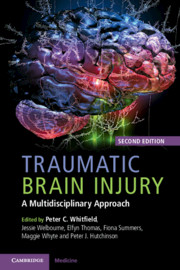Book contents
- Traumatic Brain Injury
- Traumatic Brain Injury
- Copyright page
- Contents
- Contributors
- Foreword to First Edition
- Foreword to Second Edition
- Chapter 1 Epidemiology of Head Injury
- Chapter 2 The Neuropathology of Traumatic Brain Injury
- Chapter 3 Experimental Models of Traumatic Brain Injury
- Chapter 4 Clinical Assessment of the Head-Injured Patient
- Chapter 5 Neuroimaging in Trauma
- Chapter 6 Scoring Systems for Trauma and Head Injury
- Chapter 7 Early Phase Care of Patients with Mild and Minor Head Injury
- Chapter 8 Early Phase Care of Patients with Moderate and Severe Head Injury
- Chapter 9 Interhospital Transfer of Brain-Injured Patients
- Chapter 10 Principles of Head Injury Intensive Care Management
- Chapter 11 Intracranial Pressure Monitoring in Head Injury
- Chapter 12 Multimodality Monitoring in Head Injury
- Chapter 13 Therapeutic Options in Neurocritical Care
- Chapter 14 Therapeutic Options in Neurocritical Care
- Chapter 15 Brain Stem Death and Organ Donation
- Chapter 16 Anaesthesia for Emergency Neurosurgery
- Chapter 17 Surgical Issues in the Management of Head-Injured Patients
- Chapter 18 Craniofacial Trauma
- Chapter 19 Cranioplasty after Head Injury
- Chapter 20 Neurosurgical Complications of Head Injury
- Chapter 21 Paediatric Head Injury Management
- Chapter 22 Assessment of Cognition and Capacity
- Chapter 23 Families
- Chapter 24 Principles of Rehabilitation
- Chapter 25 MDT and Rehabilitation of Head Injury
- Chapter 26 Neuropsychological Rehabilitation
- Chapter 27 Assistive Technology and Rehabilitation
- Chapter 28 Outcomes and Prognosis
- Chapter 29 Medicolegal Aspects of Traumatic Brain and Cervical Spine Injury
- Index
- References
Chapter 2 - The Neuropathology of Traumatic Brain Injury
Published online by Cambridge University Press: 28 April 2020
- Traumatic Brain Injury
- Traumatic Brain Injury
- Copyright page
- Contents
- Contributors
- Foreword to First Edition
- Foreword to Second Edition
- Chapter 1 Epidemiology of Head Injury
- Chapter 2 The Neuropathology of Traumatic Brain Injury
- Chapter 3 Experimental Models of Traumatic Brain Injury
- Chapter 4 Clinical Assessment of the Head-Injured Patient
- Chapter 5 Neuroimaging in Trauma
- Chapter 6 Scoring Systems for Trauma and Head Injury
- Chapter 7 Early Phase Care of Patients with Mild and Minor Head Injury
- Chapter 8 Early Phase Care of Patients with Moderate and Severe Head Injury
- Chapter 9 Interhospital Transfer of Brain-Injured Patients
- Chapter 10 Principles of Head Injury Intensive Care Management
- Chapter 11 Intracranial Pressure Monitoring in Head Injury
- Chapter 12 Multimodality Monitoring in Head Injury
- Chapter 13 Therapeutic Options in Neurocritical Care
- Chapter 14 Therapeutic Options in Neurocritical Care
- Chapter 15 Brain Stem Death and Organ Donation
- Chapter 16 Anaesthesia for Emergency Neurosurgery
- Chapter 17 Surgical Issues in the Management of Head-Injured Patients
- Chapter 18 Craniofacial Trauma
- Chapter 19 Cranioplasty after Head Injury
- Chapter 20 Neurosurgical Complications of Head Injury
- Chapter 21 Paediatric Head Injury Management
- Chapter 22 Assessment of Cognition and Capacity
- Chapter 23 Families
- Chapter 24 Principles of Rehabilitation
- Chapter 25 MDT and Rehabilitation of Head Injury
- Chapter 26 Neuropsychological Rehabilitation
- Chapter 27 Assistive Technology and Rehabilitation
- Chapter 28 Outcomes and Prognosis
- Chapter 29 Medicolegal Aspects of Traumatic Brain and Cervical Spine Injury
- Index
- References
Summary
The neuropathological changes associated with head injuries are dependent on a number of factors, including both the type and severity of the injury, and the former can be divided into non-missile and missile types of injury. Non-missile injury (or blunt head injury) is usually due to rapid acceleration or deceleration of the head, with or without impact, or less commonly crushing of the head, and most often occur as the result of road traffic accidents or falls. Missile injuries are due to penetration of the skull by a rapidly moving external object, for example gunshot wounds, and result in a different pattern of brain injury. The neuropathology can be separated into focal (or localised) lesions such as contusions, haemorrhages, skull fractures, or diffuse changes such as diffuse axonal injury, diffuse vascular injury, brain swelling and ischaemia (see Table 2.1).
- Type
- Chapter
- Information
- Traumatic Brain InjuryA Multidisciplinary Approach, pp. 12 - 23Publisher: Cambridge University PressPrint publication year: 2020
References
- 1
- Cited by

